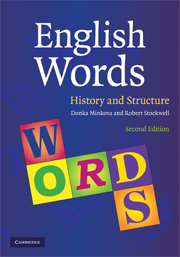Book contents
- Frontmatter
- Contents
- Preface to the second edition and acknowledgements
- An introduction to the textbook
- 1 Word-origins
- 2 The background of English
- 3 Composition of the Early Modern and Modern English Vocabulary
- 4 Smaller than words: morphemes and types of morphemes
- 5 Allomorphy, phonetics, and affixation
- 6 Replacement rules
- 7 Deletion rules and other kinds of allomorphy
- 8 Fossilized allomorphy: false cognates and other etymological pitfalls
- 9 Semantic relations and semantic change
- 10 The pronunciation of classical words in English
- Appendix: morpheme list
- Index
- References
2 - The background of English
Published online by Cambridge University Press: 05 June 2012
- Frontmatter
- Contents
- Preface to the second edition and acknowledgements
- An introduction to the textbook
- 1 Word-origins
- 2 The background of English
- 3 Composition of the Early Modern and Modern English Vocabulary
- 4 Smaller than words: morphemes and types of morphemes
- 5 Allomorphy, phonetics, and affixation
- 6 Replacement rules
- 7 Deletion rules and other kinds of allomorphy
- 8 Fossilized allomorphy: false cognates and other etymological pitfalls
- 9 Semantic relations and semantic change
- 10 The pronunciation of classical words in English
- Appendix: morpheme list
- Index
- References
Summary
A quick scan of a couple of pages in a dictionary that records the origin of our vocabulary reveals that many entries in it are historically “un-English.” This is not surprising; languages travel with the people who speak them. No language in the world today uses vocabulary which is entirely free of foreign influence, just as no country's population can remain completely indigenous. A genetically “pure” language is as hard to imagine as a genetically “pure” population. Like the society we live in, the language we speak is a product of history. Like nations and governments, languages differ in their attitude and adaptability to external pressure. Periods of hostility, isolation, self-sufficiency, follow upon periods of openness, constructive interaction, and peaceful coexistence with the outside world. The overall inventory of words used in a language is the outcome of millennia of cultural, political, and intellectual history. In many ways our vocabulary mirrors the events which have taken place in the history of English-speaking peoples. The purpose of this chapter is to highlight the important socio-historical events and circumstances which have shaped our vocabulary. We start with some basic notions and facts about the place of English within the enormously broad picture of languages of the world.
Information
- Type
- Chapter
- Information
- English WordsHistory and Structure, pp. 24 - 45Publisher: Cambridge University PressPrint publication year: 2009
